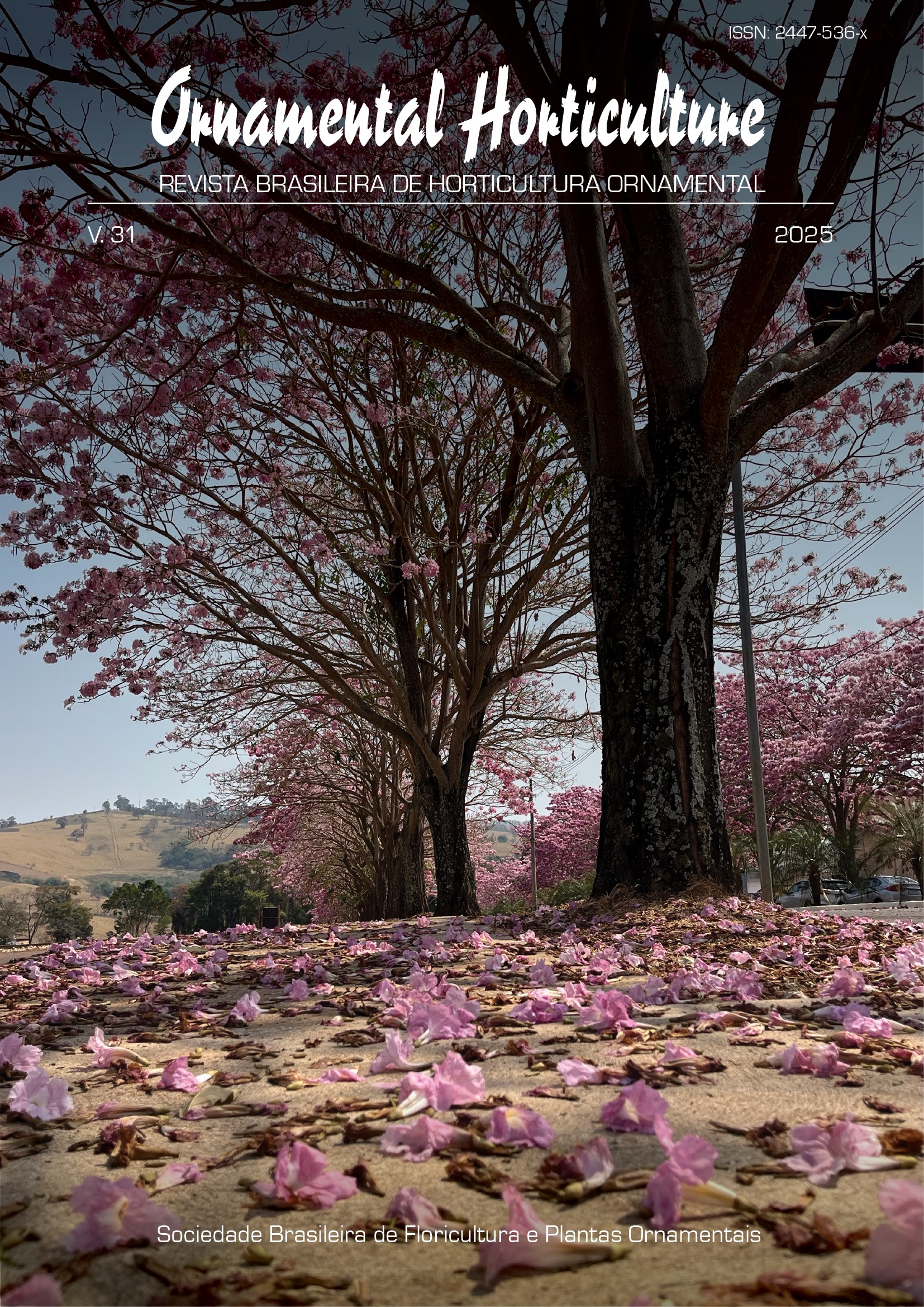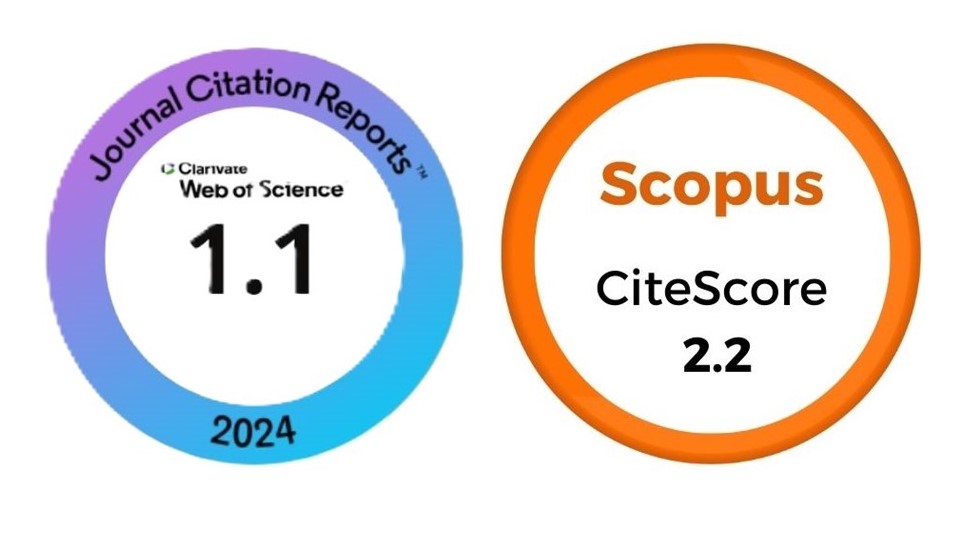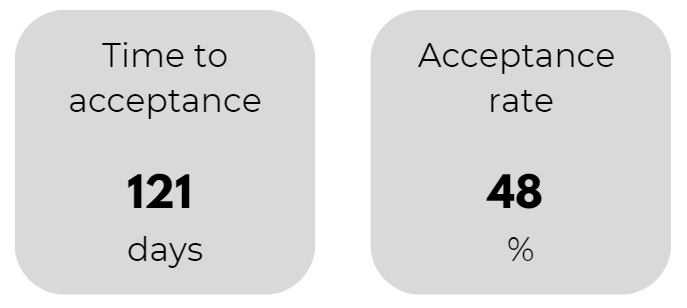Conservação e propagação de Drosera schwackei: criopreservação, germinação in vitro e desenvolvimento de uma espécie carnívora ornamental
DOI:
https://doi.org/10.1590/2447-536X.v31.e312831Palavras-chave:
conservação, Droseraceae, micropropagação, plantas ornamentaisResumo
Drosera schwackei (Droseraceae) é uma espécie carnívora com grande potencial ornamental, mas ainda não há protocolos estabelecidos para seu cultivo e conservação. O objetivo deste estudo foi desenvolver um protocolo para germinação in vitro, desenvolvimento vegetal e criopreservação das sementes de D. schwackei. O experimento foi conduzido em delineamento inteiramente casualizado, com esquema fatorial 2 x 4 (duas concentrações de hipoclorito de sódio e quatro tempos de imersão), com quatro repetições, cada uma contendo 30 sementes. As sementes foram cultivadas em diferentes concentrações do meio MS (MS1/3, MS1/2, MS100% e controle com ágar/água). Dois experimentos foram realizados para avaliar o desenvolvimento in vitro das plântulas: 1) Teste com diferentes concentrações de sais do meio MS (1/3, 1/2 e 100%); 2) Meio MS1/3 suplementado com diferentes concentrações de BAP (6-benzilaminopurina). Para criopreservação, as sementes foram armazenadas em criotubos, imersas em nitrogênio líquido por 1, 6, 12, 24, 48 e 120 horas, com um grupo controle inoculado no mesmo dia. A desinfestação com hipoclorito de sódio a 2% por 10 minutos foi eficiente e estimulou a germinação. Os meios MS1/3 e MS1/2 favoreceram a germinação e o crescimento das plântulas, enquanto baixas concentrações de BAP promoveram um melhor desenvolvimento das plantas. As sementes sobreviveram à criopreservação por até 120 horas em nitrogênio líquido, sem prejuízos ao desenvolvimento ou morfologia das plantas. O musgo esfagno mostrou ser um substrato eficiente para a aclimatação das mudas de D. schwackei oriundas do cultivo in vitro.
Downloads
Referências
AHMED, N.; SHAHID, M.; SIOW, K.S.; WEE, M.F. M. R.; HARON, F.F.; PATRA, A.; FAZRY, S. Germination and growth improvement of papaya utilizing oxygen (O2) plasma treatment. Journal of Physics D: Applied Physics, v.55, n.25, 255205, 2022. https://doi.org/10.1088/1361-6463/ac6068
BERTSOUKLIS, K.; THEODOROU, P.; ARETAKI, P.E. In vitro propagation of the mount parnitha endangered species Sideritis raeseri subsp. Attica. Horticulturae, v.8, n.12, p.1114, 2022. https://doi.org/10.3390/horticulturae8121114
BRAZIL. Ministério da Agricultura, Pecuária e Abastecimento. Regras para análise de sementes. Brasília: Ministério da Agricultura, Pecuária e Abastecimento, 2009. p.395.
CROSS, A.T.; KRUEGER, T.A.; GONELLA, P.M.; ROBINSON, A.S.; FLEISCHMANN, A.S. Conservation of carnivorous plants in the age of extinction. Global Ecology and Conservation, v.24, e01272, 2020. https://doi.org/10.1016/j.gecco.2020.e01272
DARWIN, C. R. Insectivorous plants. D. New York: Appleton & Co., 1875. 462p.
DEINLEIN, U.; STEPHAN, A.B.; HORIE, T.; LUO, W.; XU, G.; SCHROEDER, J.I. Plant salt-tolerance mechanisms. Trends in Plant Science, v.19, n.6, p.371-379, 2014. https://doi.org/10.1016/j.tplants.2014.02.001
ELLISON, A.M.; GOTELLI, N.J. Energetics and the evolution of carnivorous plants – Darwin’s ‘most wonderful plants in the world’. Journal of Experimental Biology, v.60, n.1, p.19–42, 2009. https://doi.org/10.1093/jxb/ern179
FLEISCHMANN, A.; CROSS, A.T.; GIBSON, R.; GONELLA, P.M.; DIXON, K.W. Systematics and Evolution of Droseraceae. In: ELLISON, A.; ADAMEC, L. (Eds.). Carnivorous plants: physiology, ecology and evolution. Oxford: University Press, 2018. p.45-57. http://doi.org/10.1093/oso/9780198779841.001.0001
GONELLA, P.M.; RIVADAVIA, F.; FLEISCHMANN, A. Drosera magnifica (Droseraceae): the largest New World sundew, discovered on Facebook. Phytotaxa, v. 220, n.3, p.257–267, 2015. http://dx.doi.org/10.11646/phytotaxa.220.3.4
GONELLA, P.M.; SANO, P.T.; RIVADAVIA F.; FLEISCHMANN, A. A synopsis of the genus Drosera (Droseraceae) in Brazil. Phytotaxa, v.553, p.1-76, 2022. https://doi.org/10.11646/phytotaxa.553.1.1
JAN, S.; SINGH, R.; BHARDWAJ, R.; AHMAD, P.; KAPOOR, D. Plant growth regulators: a sustainable approach to combat pesticide toxicity. 3 Biotech, v.10, n.466, p.1-12, 2020. https://doi.org/10.1007/s13205-020-02454-4
JAYARAM, K.; PRASAD, M.N.V. Rapid in vitro multiplication of Drosera indica L.: a vulnerable, medicinally important insectivorous plant. Plant Biotechnology Reports, v.1, p.79–84, 2007. https://doi.org/10.1007/s11816-007-0014-7
JOSE, J.V. Physiological and molecular aspects of macronutrient uptake by higher plants. In: Sustainable Plant Nutrition: Molecular Interventions and Advancements for Crop Improvement; Cambridge: Academic Press, 2023. p.1-21. https://doi.org/10.1016/B978-0-443-18675-2.00010-9
JUNIPER, B.E.; ROBINS, R.J.; JOEL, D.M. The carnivorous plants. London: Academic Press Limited, 1989. 353pp.
KASHYAP, P.; KUMAR, S.; SINGH, D. Performance of antifreeze protein HrCHI4 from Hippophae rhamnoides in improving the structure and freshness of green beans upon cryopreservation. Food Chemistry, v.320, 126599, 2020. https://doi.org/10.1016/j.foodchem.2020.126599
KATOGI, T.; HOMAN, Y.; TAKAHASHI, C.; SHIRAKAWA, J.; HOSHI, Y. A Comparative study of biseriate glandular trichomes of allopolyploid species Drosera tokaiensis and Its parental species. Cytologia, v.87, n.4, p.353-361, 2022. https://doi.org/10.1508/cytologia.87.353
KUMAR, S.; MISHRA, S. 2021. Sundews. Available at: https://www.researchgate.net/publication/352172450. Accessed on: jun. 09 2024.
MAGUIRE J.D. Speed of germination-aid in selection and evaluation for seedling emergence and vigor. Crop Science, v.2, p.176-177, 1962.
MEHBUB, H.; AKTER, A.; AKTER, M.A.; MANDAL, M.S.H.; HOQUE, M.A.; TULEJA, M.; MEHRAJ, H. Tissue culture in ornamentals: cultivation factors, propagation techniques, and its application. Plants, v.11, p.,3208, 2022. https://doi.org/10.3390/plants11233208
MIHOVILOVIĆ, B.A.; KEREŠA, S.; LAZAREVIĆ, B.; TOPOLOVEC PINTARIĆ, S.; MARTINKO, K.; MARKOVIĆ, Z.; TURKALJ, K.; HABUŠ JERČIĆ, I. The use of sodium hypochlorite and plant preservative mixture significantly reduces seed-borne pathogen contamination when establishing in vitro cultures of wheat (Triticum aestivum L.) Seeds. Agriculture, v.14, n.4, p.556, 2024. https://doi.org/10.3390/agriculture14040556
MOSA, K.A.; AHMED, A.E.; HAZEM, Y.; KANAWATI, I.S.; ABDULLAH, A.; HERNANDEZ-SORI, L.; ALI, M.A.; VENDRAME, W. Insights into cryopreservation, recovery and genetic stability of medicinal plant tissues. Fitoterapia, v.169, 2023. https://doi.org/10.1016/j.fitote.2023.105555
NAZIR, U.; GUL, Z.; SHAH, G.; KHAN, N. Interaction effect of auxin and cytokinin on in vitro shoot regeneration and rooting of endangered medicinal plant Valeriana jatamansi Jones through tissue culture. American Journal of Plant Sciences, v.13, p.223-240, 2022. https://doi.org/10.4236/ajps.2022.132014
PÊGO, R.G.; PAIVA, P.D.O.; PAIVA, R. Micropropagation of Syngonanthus eleganthulus. Ciência e Agrotecnologia, v.37, p.32-39, 2013.
POPOVA, E.; KULICHENKO, I.; KIM, H.H. Critical role of regrowth conditions in post-cryopreservation of in vitro plant germplasm. Biology, v.12, p.542, 2023. https://doi.org/10.3390/biology12040542
PRADA, J.; AGUILAR, M.; ABDELNOUR-ESQUIVEL, A.; ENGELMANN, F. Cryopreservation of Seeds and Embryos of Jatropha curcas L. American Journal of Plant Sciences, v.6, p.172-180, 2015.
REIS, E.S.; PINTO, J.E.B.P.; ROSADO, L.D.S.; CORRÊA, R.M. Influência do meio de cultura na germinação de sementes in vitro e taxa de multiplicação de Melissa officinalis L. Revista Ceres, v.55, p.160-167, 2008.
RIVAS, M.A.; FRIERO, I.; ALARCÓN, M.V.; SALGUERO, J. Auxin-cytokinin balance shapes maize root architecture by controlling primary root elongation and lateral root development. Frontiers in Plant Science, v.13, 836592, 2022. https://doi.org/10.3389/fpls.2022.836592
RUAN, J.; YI, P. Exogenous 6-benzylaminopurine inhibits tip growth and cytokinesis via regulating actin dynamics in the moss Physcomitrium patens. Planta, v. 256, n.1, 2022. https://doi.org/10.1007/s00425-022-03914-2
RUTA, C.; LAMBARDI, M.; OZUDOGRU, E. A. Biobanking of vegetable genetic resources by in vitro conservation and cryopreservation. Biodiversity Conservation, v.29, p.3495-3532, 2020. https://doi.org/10.1007/s10531-020-02051-0
SAFITRI, D.C.Y.; HANDINI, E.; APRILIANTI, P.; ISNAINI, Y.; SEMIARTI, E. Improvement of Growth Rate in In Vitro Culture of Paphiopedilum primulinum M. W. Wood & P. Taylor and Paphiopedilum glaucophyllum J. J. Smith using Banana Enrichment Media. Tropical Life Sciences Research, v.35, n.3, p.109-120, 2024. https://doi.org/10.21315/tlsr2024.35.3.5
SASAMORI, M.H.; ENDRES JÚNIOR, D.; DROSTE, A. Optimal conditions for in vitro culture of Cattleya cernua, a small orchid native of Atlantic Forest and Cerrado. Rodriguésia, v.72, e01982019, 2021. https://doi.org/10.1590/2175-7860202172059
SCHAFER, G.; LERNER, B.L. Physical and chemical characteristics and analysis of plant substrate. Ornamental Horticulture, v.28, n.2, p.181- 192, 2022. https://doi.org/10.1590/2447-536X.v28i2.2496
SENDER, J.; RÓŻAŃSKA-BOCZULA, M.; URBAN, D. Active protection of endangered species of peat bog flora (Drosera intermedia, D. anglica) in the Łęczna-Włodawa Lake District. Water, v.14, n.18, p.1- 14, 2022. https://doi.org/10.3390/w14182775
SILVA, M.W.; BARBOSA, L.G.; SILVA, J.E.S.B.; GUIRRA, K.S.; GAMA, D.R.S.; OLIVEIRA, G.M.; DANTAS, B.F. Caracterization of
seed germination of Zephyranthes sylvatica (Mart.) Baker (Amarilidacea). Journal of Seed Science, v.36, n.2, p.178-185, 2014. https://doi.org/10.1590/2317-1545v32n2923
ZAIDI, C.A.; GONZÁLEZ-BENITO, M.E.; PÉREZ-GARCÍA, F. Morphology germination and cryopreservation of seeds of the Mediterranean annual plant Tuberaria macrosepala (Cistaceae). Plant Species Biology, v.25, p.149–157, 2010.
ZARZYCKI, K.; SZELĄG, Z. Red list of the vascular plants in Poland. In: Red list of plants and fungi in Poland. Szafer, W. Kraków: Institute of Botany Polish Academy of Sciences, 2006. p.9-20.
Downloads
Publicado
Edição
Seção
Licença
Copyright (c) 2025 Ornamental Horticulture

Este trabalho está licenciado sob uma licença Creative Commons Attribution 4.0 International License.








